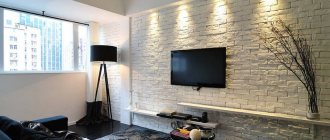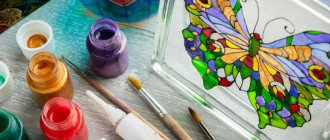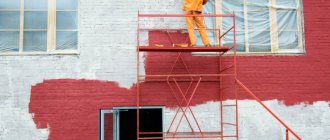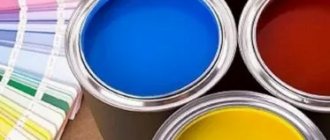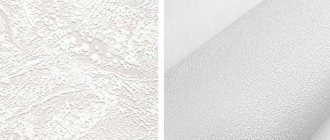Painting a glass surface can give a new look to the material and help change the interior of your home; you can paint a variety of glass, but you need to understand that the process is not as easy as when working with other substrates. This is explained by the smoothness of the surface, which is difficult for paint and varnish products to adhere to. How to paint glass correctly will be discussed in more detail below.
Stained glass
In addition to the richness of the range of colors, the material is distinguished by the choice of consistency, which will depend on the composition. The classification of this type is based on the main component:
- Water based . Opaque hypoallergenic paint, the action of which is similar to oil compositions. It has a number of disadvantages. The first is an insufficiently saturated palette due to the lack of resins in the composition. The second is a short shelf life. Firing is required for fixation. For uniform application, you must have experience working with this type of material.
- Alcohol paint . It is characterized by increased resistance to the external environment. It is characterized by brightness, saturation and brilliance. A brush is used for application, and special solvents are used for removal. There is no need for firing.
- Varnish based . Has a characteristic smell. It hardens within a few days, without requiring additional procedures. Diluted with a special solvent.
Review of stained glass paints that I use
Here I have collected information on stained glass paints for glass that I use in my works.
This is not a review of all existing stained glass paints, or even a review of glass paints that exist on the shelves of art stores in Moscow. This is exclusively a story about the stained glass paints that I use.
All photographs are of my actual and used jars and outlines, so they are stained, used, etc.
So…
For myself, I divide stained glass paints for glass into 2 types - fired and unfired. But, in addition, there are also divisions - for example, on paint solvent or water, and others.
Stained glass paints with firing
The name “fired” speaks for itself - these paints must undergo mandatory firing in the oven. The temperature and firing time of paints from different manufacturers are different; it is better to look at them on each specific jar. But usually the temperature is from 120°C to 160°C, and the time is from half an hour to an hour and a half. After such heat treatment, the products can be safely washed and generally used. It is still not recommended to scratch them with a knife or nails, but their strength is much higher than that of unfired glass paints. Therefore, when painting mugs, glasses and other things that need to be washed frequently, I use only burnt paints.
By the way, as long as the paints are not burned, they are removed very easily, and the drawing must be treated carefully. True, only the first week. Then the paints dry to the glass and you have to soak them for a long time to wash off the drawing.
When firing, the painted item is placed in a cold oven, and then the temperature is adjusted. It’s better to have a thermometer (built into the oven or purchased separately), and set the temperature a little lower than that specified by the manufacturer, because when overheated, the paint turns brown (and what happens to its strength is unknown. But hardly anything good). It is also better to remove the burned item from the already cooled oven so that there is no temperature difference.
All the fired stained glass paints that I have come across are water based, not solvent based. Those. The brushes are washed with plain water. Plus, these paints do not smell, which is also convenient. For allergy sufferers, for example, this is simply a salvation, and in general it’s more pleasant to use.
In the store, fired paints can be identified by the word “Porzellan” or “Porcelain” (depending on the language) on the jar or by the temperature - next to the name there is the number “150”, for example. Yes, Porzellan translates to porcelain, but they are as transparent as stained glass paints.
Fired glass paints that I use:
"Pebeo":
"Hobbyline":
Contours for burnt paints, of course, also need to be used only burnt paints. But whether they are made of glass or porcelain - it doesn’t matter here, both will be equally good.
The contours of all companies are mostly opaque, but they have multi-colored transparent ones. The only exception to Pebe's transparent outlines is their supposedly "transparent" which actually turns out to be pearly white.
Outlines - “Pebeo”, transparent:
and opaque:
Addition:
Fired stained glass paints have one drawback - they are not as brightly transparent as unfired ones. They are more matte; the back of the glass, for example, is difficult to see through them.
Here, for comparison:
fired unfired
Stained glass paints without firing
Unfired paints for glass are brighter, their colors are more saturated and vibrant.
They are mostly solvent-based (except for Marabou, which I will talk about separately) - the brushes are also washed with solvent. All companies have their own solvents, plus solvents can be bought at art stores, but I mainly use either white spirit or acetone. Nail polish remover will also work.
You must remember to wash your brushes on time, otherwise after drying they can be thrown away... You must remember to cover the paints, both unfired and fireable, otherwise they will quickly dry out right in the jar.
After applying, first the contour and then the paint must be allowed to dry. Manufacturers call the period from 24 hours to 3 weeks (it is better to read the instructions on the jar). After this, you can start using the product.
In terms of durability, paints behave differently, but generally, after a month of drying, they can be easily washed, although not soaked.
Paints and contours for glass that I use:
"Idea vetro":
"Pebeo Vitrail":
"Hobbyline":
"Marabu Decor Glass":
Contours - to unfired paints - again unfired contours:
"Idea":
"Marabu":
If the first three paints are quite the same both in quality and in use, then I’ll say something about the last one separately:
“Marabu Decor Glass” are water-based stained glass paints (Marabu also has resin paints).
The brushes are washed with water.
But! Until the paints have dried, they are opaque. Transparency increases as it dries. This is not always convenient.
Plus, these paints have some amazing ability to move away from the contour after application, leaving gaps. So then you have to go through all these spaces again, which is not very convenient if the paints were mixed - it is quite difficult to catch the same color.
And the contours of Marabou, although much more convenient to apply with conventional tubes, are much less durable when used...
Yes, you can’t find these paints in all stores.
And more about the unburnt ones:
All non-fired glass paints can be fired.
None of the manufacturers recommend doing this. But many of my friends who use unfired paints burned them (and I myself constantly burn Marabou). Temperature - 110-120°C, time - 30-40 minutes.
But I’ll say it again - this is pure homemade work, none of the manufacturers recommend burning these paints, except for Marabou, who say that although you can burn it, it will not add strength.
Moscow stores that sell glass paints (and not only those listed here):
“Peredvizhnik” - metro station “Mayakovskaya”, metro station “Novoslobodskaya”, Fadeeva st., 6, tel. 22-55-082
“3 color” - metro station “Chistye Prudy”, Gusyatnikov lane, 13/3 building 1, tel. (495) 623-22-03
Art department of the Central Children's World, Taganskaya metro station, st. Bolshie Kamenshchiki, 4. Exit from the radial branch of bodies. 8-901-535-24-52
“Artichoke” - metro station “Novokuznetskaya”, “Tretyakovskaya”, Pyatnitskaya st., 5, entrance to the arch, Shopping center, tel: 953-64-48. This store sells Marabu paints
shop at the Central House of Artists (Central House of Artists) - metro station "Oktyabrskaya", "Park Kultury", Krymsky Val, 10, tel. 230-19-13, 729-47-43
“Everything for the artist” - metro station “Oktyabrskaya”, “Park Kultury”, st. Krymsky Val, 8, bldg. 2 (Building of the Art Lyceum), tel. 247-87-56
“FINE ARTS” - metro station “Kitay-Gorod”, st. Zabelina, 1, tel. 974-68-28, 625-09-28
“Chernaya Rechka” - metro station “Shabolovskaya”, st. M. Kaluzhskaya building 1, store in the building of the Textile University, tel: 955-35-76
"Chernaya Rechka" - metro station "VDNKh", Yaroslavskoe highway 3/3, travel by bus 244,172,136 or trolleybus 76 to the stop "Poligraphic College", tel: 188 98 92, 188-98-01, 183-57-16
- metro station "Pervomaiskaya", st. Pervomaiskaya, 1/2. exit from the metro to the street. Pervomaiskaya, then take trolleybus No. 22 to the “fur factory” stop. shop next to the bus stop. tel: 367-06-48, 367-55-90
“Workshop of Ideas”: metro station “Polyanka”, st. Bolshaya Polyanka, 28, building 1, zero level of the Perekrestok supermarket. 100 meters from the metro, right behind the “Young Guard” store, tel: 542-19-96; m. "Taganskaya", st. Nizhnyaya Radishchevskaya, 5, building 1. If you stand facing the entrance to the Taganskaya metro station on the Circle Line, then ten meters to the left there will be a two-story building. Shop on the ground floor.
Acrylic
Acrylic-based paint has a rich palette, and the shades are easily mixed with each other. Small areas can be painted with a brush, but it is more popular to use acrylic mixtures in an aerosol can format. To increase stability, it is not necessary to resort to firing - it is enough to apply acrylic varnish on top of the dried drawing and the product will not be subject to fading in the sun and temperature fluctuations.
Separately, it is worth highlighting acrylic polymers - this is a technology for painting with a special composition based on acrylic resin. Quick-drying coating that does not require additional processing. It is highly resistant to water, chemicals and other external factors. When working, it is not necessary to use special tools. The method makes it possible to coat workpieces of any shape and size. The image can be either a single color or a complex multi-component pattern.
Ink, felt-tip pens, markers
There are special felt-tip pens for working with glass or ceramic surfaces. They are created in such a way that, if necessary, the applied image can be removed.
An ideally smooth canvas can be coated with a special ink that has high adhesive properties. With its help you can achieve clear lines. Application is done using a rapidograph. This tool distributes the mascara in such a way that a line of a certain thickness is obtained.
Cleaning
The fabric to be painted must be clean. If the glass is slightly dirty, just wipe it with a soft cloth or damp cotton pad. It is not recommended to use synthetic materials, because... If pressed hard, they can dull the surface.
If small and medium-sized glasses are heavily soiled, you can wash them in the bathroom:
- Place the cloth in the bath and clean it with a napkin, while pouring warm water from the shower over it.
- After cleaning, the glass is thoroughly wiped dry - if you leave the surface wet, streaks will appear on it after drying.
After this, it is necessary to immediately proceed to the next stage of work, since the friction of fabric materials on the surface of the glass charges the latter with static electricity. The electrified canvas attracts dust, which leaves micro-scratches on the glass and interferes with painting.
If the glass initially has small scratches, it is necessary to polish it using a special paste. If you don’t have one, you can use a homemade analogue. To make it, mix soda and toothpaste in a 1:2 ratio. The mixture is applied to the damaged area, after which the glass is polished in a circular motion using a polishing roller.
Painting plexiglass
Before painting plexiglass, you need to familiarize yourself with the features of this process and purchase the necessary materials and tools.
First, the surface is cleaned of grease, dust and dirt using alcohol. Then the product is placed in a heated tsaponlak dye solution for a time that ranges from 30 seconds to 15 minutes. This indicator determines the saturation of the tone.
After the staining process is completed, the glass is quickly transferred to a container with cold water until completely cooled. Next, you need to wipe the plexiglass with a dry cloth or felt to add shine. If the color of the product is not bright enough, it can be made more saturated by repeating the entire cycle from the beginning, after thoroughly drying the treated surface.
When deciding how to paint plexiglass, it is worth deciding in advance on the color scheme and the presence of sketches, which are applied after basic painting using stencils and a paint brush.
When you decide to decorate your home with glass items painted with your own hands, you should try different techniques and coatings, and then decide on your choice. In specialized stores, you can first take materials of basic colors for dyeing, and then independently obtain different shades from them. Or you can immediately purchase a set of stained glass paints and stencils so that you no longer limit the flight of your imagination.
Protection of unpainted areas
If the glass is partially painted or installed in a frame, you need to mask off the unpainted areas. The most affordable means is masking tape . A simple and practical option that eliminates paint contamination. Glued end to end with the frame. However, the tape has disadvantages:
- Big expense.
- Minimum experience required. Otherwise, the tape will wrinkle, resulting in wrinkles.
- Changes in properties at high air temperatures. Tape glued in a warm room will stick tightly. Removing the remaining pieces of masking tape is a long and difficult process. If this happens, it is recommended to soak the strips in dishwashing liquid.
You can remove the tape only after the glass has completely dried. Otherwise, the uniformity of the layer bordering the edge of the tape will be disrupted. This is especially true in multi-layer painting.
As an alternative to masking tape, you can use cloth or paper . The fabric strip is pre-wetted in soapy water and glued to the surface. Material that is too thin may allow paint to pass through if it is not lathered well. In the second option, clean white paper should be used. When using magazine sheets and newspapers, the image will be printed on the glass. Attaches with water. Unlike masking tape, you must remove the paper as you paint. Otherwise, it will peel off on its own and stick to the freshly painted glass.
To protect hard-to-reach areas, you can use thick oil or Vaseline. After application and drying, the paint is wiped off with a rag.
Properties of painted glass
Painting the glass surface can be used for decorative purposes or for additional protection of the material. The paint gives a beautiful design to the material, highlighting the base, giving it a better look.
Dark shades can dim the lighting and reduce the amount of light entering through windows. In terms of protection, the fire-resistant property can be increased if glass is painted in the oven.
Painting the glass surface can be used for decorative purposes or for additional protection of the material.
Tools and operating procedure
The following products can be used for application:
- Flat brush.
- Hard brush.
- Spray gun.
- Paint roller.
- Foam swab.
The choice of tool is determined from the point of view of the painter's convenience and surface area. It is easier to paint small glasses with a brush, but it is impossible to paint a large canvas efficiently without a spray bottle.
Procedure:
- After preliminary preparation of the glass, you need to install it on a flat surface in a horizontal position. Otherwise, the likelihood of leaks increases. Painting in a vertical position is used only in the case of a spray gun.
- Apply the paint in an even transition without streaks. It is recommended to do at least two layers with intermediate drying. Because The material is transparent; with a single layer of painting, unpainted paint will certainly appear.
- Wait until the fresh coat dries. After this, the glass can be fired or placed in a rack to dry completely.
Methods of applying paint to glass
In order for new colors that are unusual for the base material to appear on a transparent smooth surface, a paint layer is applied. Traditionally, several staining methods are used:
- dipping, in which the entire product is lowered into the bath and then removed. The excess drains off, and only a thin film of the coloring composition remains on the surface;
- Roller painting is the simplest method, when a continuous paint coating is created on the surface to be painted by repeated rolling of a roller with dye;
- Brush painting is used to apply small spots of color or fill confined spaces. Large surfaces are difficult to paint with a brush, as local unpainting is possible;
- large panels are spray painted; using a spray gun, you can create a transparent colored film on the glass in a short period of time, which will completely change its appearance.
How to consolidate the result?
Depending on the type of paint, one of the proposed methods is used:
- Drying out . Mandatory conditions: room temperature not lower than 18 degrees and relative humidity in the range of 50-80%. The time for complete drying of glass ranges from 1 to 48 hours depending on the paint.
- Seal with varnish . The product is applied in 1-2 layers so that the surface does not become glossy. It is recommended to purchase paint and varnish from the same manufacturer.
- Firing . If it is necessary to fix heat-resistant paint, the glass is placed in a special oven. At home, you can get by with a kitchen stove oven. The painted canvas is laid out on the oven grate, after which the required temperature is set. All that remains is to note the time and wait for the product to cool completely.
How to make stained glass on glass at home
Preparation for stained glass technology is standard. The image itself is first applied along the borders with a special varnish; it serves as a barrier against paint spreading. For this reason, when making a detail in the drawing, you should not interrupt the line. After finishing the work, the result is fixed with varnish.
The image itself is first applied along the borders with a special varnish; it serves as a barrier against paint spreading.
The article described how to paint glass correctly so that it acquires a more interesting structure. There are many options for suitable paints on the market; the composition should be chosen taking into account the operating conditions. The painting process is simple, you can do it yourself.
Scope of application of painted glass
Product color changes may be required in the following areas and products:
- Wall cladding is a plain or contrasting fabric.
- Furniture production - in the decoration of cabinets, shelves, tables.
- Decoration of entertainment facilities - glass partition, bar area.
- Shopping center showcases and partitions for dividing commercial spaces.
- In living quarters - decorating functional elements in kitchen and bathroom interiors.
- Functionally decorative partition. Used for fencing stairs or elevator cabins.
What glass products can be painted?
Painting glass can be used in different situations. Designers like to use such options, but you can apply the technique yourself, and then you will be able to create a unique product. Options when glass painting may be relevant:
- By adding to the overall interior, you can get a unified design style;
- When you need to quickly finish doors between rooms or entrances;
- Painting glass structures to make them look better and more attractive;
- Painted glass can complement cabinets, tables and other furniture items, and is suitable for working with mirrors;
- It is used to create accessories from this material; in this case, the process involves small work that requires special precision.
Painting glass can be used in different situations.

